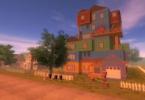Until recently, the DRL (arc mercury fluorescent) lighting lamp was the most common in street lamps. However, DNaT lamps in many lighting technical characteristics are superior to DRL lighting lamps, but nevertheless, today they have big choice and they are still used in many places. First of all, this is due to the color rendition, for DRL is a white daytime color, for DNaT it is orange.
The principle of operation of the DRL lighting lamp
Illumination lamp arc mercury fluorescent
- - a glass flask filled with mercury vapor
- - an ordinary base, maybe E14, 27, 40
- - burner
- - main working electrodes
- - ignition electrode
- - limiting resistor starting current
Principle of operation
Voltage is applied to the main and ignition electrodes. Since they are close to each other, a glow discharge is formed and a a large number of free electrons and positive ions... This thereby causes a discharge between the working electrodes, and it is converted into an arc and a discharge that emits a strong ultraviolet radiation... It does not create light visible to the human eye. For this reason, a layer of phosphor is applied to the inside of the bulb, which, using the luminescence effect, creates the illumination that we know and see.
Features of work
Illumination mercury fluorescent lamp is directly proportional to the voltage of the mains supply. When it is lowered by 10 %, illumination decreases by 20 – 25 %. If the voltage drops to 80% of the nominal ( 220 V), then it may not ignite, and the working one may go out. It gets very hot during use. For this reason, it is recommended to use heat-resistant wires when connecting the socket in luminaires. During switching on, a large current passes through it, and mercury vapor gradually turns into a gaseous state. Stabilization of processes to a working one lasts 10 - 15 minutes. It is also worth noting that the lower the temperature, the longer it will flare up. If the voltage disappears and the lamp goes out, then it will not turn on again until it cools down.
Fig. 2. Lighting characteristics
As can be seen from the table, the energy efficiency of DRL lamps ( 50 - 60 Lumens / Watt) is significantly less than DNaT ( 80 - 120 Lumens / Watt). But, nevertheless, they are widely used to illuminate courtyards, streets, gardens, parks, as well as to illuminate houses and buildings. The main type of luminaires where they are used is housing and communal services.
Connection diagram
Rice. 3. Choke connection

If you turn it on without connecting the DRL throttle, then it will burn out. The choice of the choke is carried out in accordance with its power. Most common power 125, 250, 400 W... The inductor reduces the starting current, and the capacitor compensates for the reactive component of the power, which saves electricity up to 50 %. The choke and capacitor are ballasts that come with the luminaire.
V recent times DRL lighting lamps of direct connection appeared on sale, that is, they are connected to the network without a choke.
Since mercury vapors are inside the DRL, special requirements are imposed on its storage.
Since the lamps high pressure DRL 250 are distinguished by their durability, reliability and high efficiency in comparison with standard incandescent lamps, then they are often used to create lighting on summer cottages, in the courtyards of private houses, garages, etc. By themselves, such lamps are quite simple to purchase in any specialty store, they have a very reasonable price and are very common. The problem is that the choke that goes into the lamp power circuit is made of copper and can be much more expensive. Therefore, the author decided to try to make a similar choke on his own.
Materials and tools that the author used to create homemade DRL 250 lamp chokes:
1) 40 watt chokes from an LD 40 lamp
2) 80 watt chokes from LD 80 lamps
3) wires
4) blowtorch
5) soldering accessories
Let us consider in more detail, using the example of photographs, how exactly to assemble a homemade choke for DRL 250 lamps.
As mentioned above, conventional chokes for a DRL 250 lamp are quite expensive, since they consist of copper wire. So he decided to make it himself from cheaper ones. similar materials... As such materials, the author chose other chokes from less powerful lamps daylighting.
Before using DRL 250 lamps, the author used LD 40 and LD 80 lamps, which have chokes for 40 and 80 watts, respectively. Therefore, it was decided to create a choke for the DRL 250 from them. Having made some calculations, the author received that for one DRL 250 choke, at least two 80-watt chokes and one 40-watt choke are needed.

Below is a diagram of their connection:
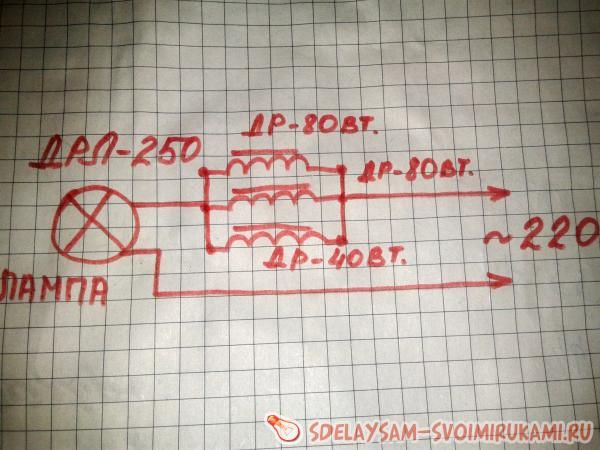
As can be seen from the diagrams, all chokes are connected in parallel, thus forming a common ballast. This is important because for sequential inclusion inductance inductors will add up and inductive reactance increases accordingly. Therefore, when connected in series, the current will be limited to the level of a 20-watt lamp.
One of the wires coming from the outlet standard socket with a voltage of 220 V, the author connected it to one of the ends of the choke, and put the other wire from the socket directly onto the lamp. The author connected the wire that goes from the output of the chokes to the second contact of the lamp. Practical use a similar scheme is shown in the photos below:

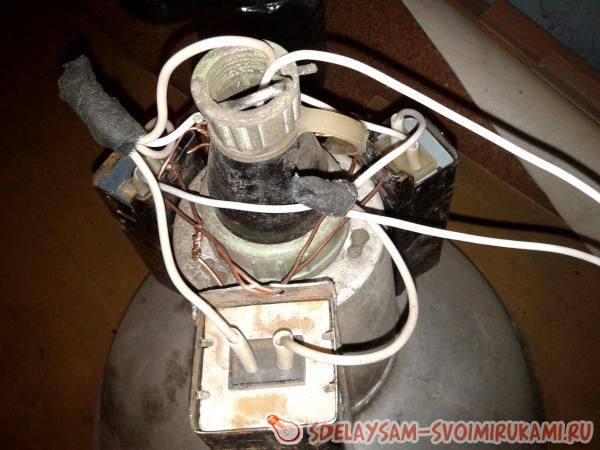

In these photos, it is also noticeable how the wires are connected. The author notes that it is necessary to make sure that the contacts on the terminals of the chokes have enough good connection otherwise they will spark and heat up, which may cause damage.
The next photo shows how the work of such a throttle is carried out and that it is capable of starting DRL lamp 250:

According to the author's assurances, such a scheme is reliable enough for use. So he assumes in the future to use a separate box in which the chokes will be located, and simply output the wires from it to the lamps. This assembly option cost the author cheaper than buying a special choke for the DRL 250 lamp. Special attention safety precautions, and also advises placing the lamps at a height of at least three meters, since he believes that they study quite a lot of ultraviolet radiation.
To make it convenient and comfortable in the dark, various lighting intended for outdoor street lighting... Details about all types -. They differ in shape, type of light elements used, power, mounting methods and other characteristics. Although today a large number of alternative models have appeared, one of the most common are lamps for DRL lamps.

DRL - high pressure mercury arc phosphor lamp (gas-discharge mercury lamp), designed for night street lighting and large-scale technical and general purpose... Is different increased luminous efficiency, since it has additional electrodes. Gas-discharge mercury light cells have a number of advantages, which allows them to remain popular with housing and communal services and in the private sector.
- Powerful- at standard power consumption (220 W network), range from 125 to 1000 W.
- Bright- light output (Lm / W) up to 60 Lumens (luminescent "capable" of only 10 - 20 Lm / W).
- Durable- designed to work up to 20,000 hours.
- Economical- consume less energy than incandescent bulbs.
- Frost resistant- withstand very coldy without performance degradation.
The fact that DRL "step on the heels" of more modern LED elements is due to their significant shortcomings:
- Delay- the lamp reaches its peak brightness within 7 minutes, which is not always convenient.
- Choke presence- it increases the cost of the luminaire and complicates the connection of the lamp.
- Noise accompaniment- a functioning throttle makes a hum.
- Poor color rendering- the spectrum of the lamp is limited.
- Fluctuating flow- the lamp "blinks" during operation.
- Difficulties in operation- since the working height of the luminaires is on average 4 meters, installation, replacement of lamps and cleaning of shades from midges requires special equipment.
More about street LED spotlights written in.
Luminaires with DRL are somewhat inferior to LED ones in terms of characteristics, but they outperform incandescent lamps. But in terms of a combination of price and quality, gas-discharge ones are superior to LED ones, they are more affordable.
Varieties of lamps with DRL, their parameters and cost
For DRL lamps, lamps of two main types are produced, which best suit the scope of application.
Console
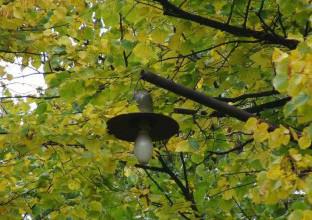
Everyone is familiar with teardrop-shaped lamps for poles, fixed at an angle of 15 ° relative to the horizontal. Designed for one or several (up to three) lamps, they have both built-in and external choke. The body and reflector are made of special sheet steel. The plafond can be completed with a protective glass cover or a metal grill. Used lamps: 125, 250, 400 W. The price depends on the power. The cost of a 400 V DRL lamp is from 2000 rubles. DRL cantilever luminaires are designed for high poles and illumination of large areas. Mounting height from 3 to 5 meters. Concerning technical characteristics then they are described above.
Crowning (floor)
Usually in the form of matte or transparent ball made of glass or polycarbonate, the base is a pillar, support or decorative cabinet. They also produce floor lamps in the form of an inverted cone, in which a glass diffuser is supplemented with a protective metal cap. The choke is located at the base of the shade, the lamp used: 125, 150 W. It's over decorative view luminaires, designed for both illumination and decoration of the site. Installation height from 3 to 5 meters.
DRL luminaires are designed for high-rise lighting. Cantilever lights give side, asymmetrical light, from floor lamps the lighting is evenly distributed. The cantilevers are equipped with reflectors and cover a substantial area.
The specific cost of lamps for DRL depends on the manufacturer and body materials, console models with protective glass and glass crowning, more expensive. On average, the price of a console lamp starts at 900 rubles, for the crowning polycarbonate version you will have to pay at least 1400 rubles. If you settled on a glass floor lamp, prepare at least 2,500 rubles.
We organize street lighting wisely

If the lighting of streets, roads and parks is carried out by municipal services, then your summer cottage or private plot each owner equips himself, based on his capabilities and preferences. DRL console lamps are the best option for the upper tier of lighting, one or more poles can be installed to completely cover the area. In addition, consoles are used to illuminate the façade, as they provide a bright, directional light output.
Floor ball lamps will look good along alleys, above benches, above gates. Being located below, relative to the cantilevers, they form the second tier. One of the advantages of DRL luminaires is their availability, on the scale of a large area, with a large number of lighting points, the savings from their use are tangible. It will turn out to be both effective and decorative.
Although the energy consumption of DRL luminaires is lower than that of incandescent lamps, if they burn all night long, the invoices will contain a significant amount. To cut down on waste, it is worth using motion sensors. They can be used to equip the lamps of the lower tier, since their light is required periodically. Another way to save money is to install a photo relay for street lighting. you will find the diagram.
Connection
Unlike other lamps, gas-discharge mercury lamps are connected to the network through a ballast (ballast) - a choke. This is a stabilizer that converts the rated mains voltage into a starting voltage, which is more than 2 times higher. Without a choke, the light will simply burn out when turned on. The circuit is a series connection of a lamp with a choke connected to the network.
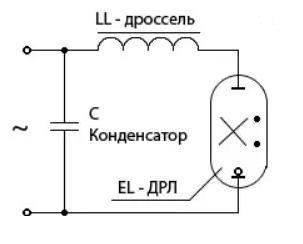
Most of the luminaires have built-in ballasts, but they are somewhat more expensive, if necessary, you can actually buy a cheap model and supply it with a choke yourself. This scheme will also come in handy for the owners of expensive lamps, since chokes are a weak point of the DRL, they burn out faster than the lamp develops its resource. The video shows in detail how to connect the choke:
DRL post lamps are durable, efficient and economical equipment that successfully combines power with decorativeness. Owners of summer cottages and household plots will simultaneously receive good lighting and beautiful design with minimal cost... However, if you do not like DRL lamps, you can choose any other.
Topic: connection diagram, characteristics, device, operation of the DRL lamp.
DRL lamp(Mercury Arc Lamp) is a high pressure mercury arc phosphor lamp. This is one of the types of electric lamps that is widely used for general illumination of large areas such as factories, streets, sites, etc. (where there are no special requirements for the color rendering of the lamps, but high luminous efficiency is required from them). DRL lamps have a power of 50 - 2000 W and are originally designed to work in electrical networks alternating current with a supply voltage of 220 V. (frequency 50 Hz.). For the lamp to work, a starting and regulating device in the form of an inductive choke is required.
Now, with regard to the device of the DRL lamp. A mercury arc lamp (DRL) consists of three main functional parts: a base, a quartz burner and a glass bulb.
Plinth designed to receive electricity from the network, by means of connecting the lamp contacts (one of which is threaded, and the second is point) with the contacts of the cartridge, after which alternating electricity is transmitted directly to the electrodes of the DRL lamp burner itself (electric mercury arc lamp).
Quartz burner is the main functional part of the DRL lamp. It is a quartz flask with 2 electrodes on each side. Two of them are basic and two are additional. The burner space is full inert gas"Argon" (to isolate heat transfer between the burner and the medium) and a drop of mercury.
Glass flask - this is outer part lamps. A quartz burner is placed inside it, to which conductors come from the contact base. Air is pumped out of the flask and nitrogen is pumped into it. And one more important element that is in the glass bulb is 2 limiting resistances (connected to additional electrodes). The outer glass bulb is coated with a phosphor from the inside.
The first versions of DRL lamps had only two electrodes, which required an additional trigger device to ignite the DRL lamp (through a high-voltage pulse breakdown of the gas gap of a quartz burner). This view lamps were discontinued and replaced with a four-electrode analogue, for which only a choke is needed.
The main characteristics of DRL lamps:

DRL lamp operation : the mains voltage is applied to the lamp, it is supplied to the gap between the main and additional electrodes, which are located on one side of the quartz burner and to the same pair located on the other side of the burner. The second gap, between which the mains voltage is concentrated, is the distance between the main electrodes of the quartz burner, located on opposite sides of it.
The distance between the main and additional electrodes is small, which makes it easy to ionize this gas gap when voltage is applied. The current in this section is necessarily limited by the resistances standing in the circuit of additional electrodes in front of the entrance of the wire conductors to the quartz burner. After ionization has occurred at both ends of the quartz burner, it is gradually transferred to the gap between the main electrodes, thereby ensuring further combustion of the DRL lamp.
The maximum burning of the DRL lamp occurs after about 7 minutes. This is due to the fact that in the cold state, the mercury in the quartz burner is in the form of a droplet or plaque on the walls of the flask. After starting, the mercury slowly evaporates under the influence of temperature, gradually improving the quality of the discharge between the main electrodes. After all the mercury turns into vapors (gas), the DRL lamp will reach the nominal operating mode and maximum light output. It should also be added that when the DRL lamp is turned off, it cannot be turned on again until the lamp has completely cooled down. This is one of the disadvantages of the llama, since it becomes dependent on the quality of the power supply.
The DRL lamp is quite sensitive to temperature and therefore an external glass bulb is provided in its design. It performs two functions: firstly, it serves as a barrier between external environment and a quartz burner, preventing the cooling of the burner (the nitrogen inside the flask prevents heat exchange), and secondly, since not the entire visible spectrum is emitted during an internal discharge (only ultraviolet and green color), then the phosphor lying thin layer on inside glass flask, converts ultraviolet light to the red light spectrum. As a result of the combination of blue, green and red radiation, a white glow of the DRL lamp is formed.
 The four-electrode lamp is connected to the mains through a choke. The choke is selected in accordance with the power of the DRL lamp. The role of the choke is to limit the current supplying the lamp. If you turn on the lamp without a choke, then it will instantly burn out, since too much electric current will pass through it. It is advisable to add a capacitor (not electrolytic) to the connection diagram. It will affect the reactive power, and this will save electricity in half.
The four-electrode lamp is connected to the mains through a choke. The choke is selected in accordance with the power of the DRL lamp. The role of the choke is to limit the current supplying the lamp. If you turn on the lamp without a choke, then it will instantly burn out, since too much electric current will pass through it. It is advisable to add a capacitor (not electrolytic) to the connection diagram. It will affect the reactive power, and this will save electricity in half.
DRL-125 choke (1.15A) = 12 microfarad capacitor. (not less than 250 V.)
DRL-250 choke (2.13A) = 25 microfarad capacitor. (not less than 250 V.)
DRL-400 choke (3.25A) = 32 microfarad capacitor. (not less than 250 V.)
P.S. The DRL lamp contains droplets of mercury inside, if a quartz bulb breaks, then mercury vapors will scatter in the room for 25 square meters. Handle the DRL lamp with care.
Since high pressure lamps DRL 250 have a fairly long term service life and high efficiency in comparison with incandescent lamps, they are successfully used for lighting summer cottages, the courtyard of a private house, and sometimes even garages inside.
They have proven their reliability over the years, the quality of lighting, and all this for a small amount. It will not be difficult to purchase a DRL 250 lamp. It is available in both specialized stores and markets.

The problem may be a choke that is included in the lamp power circuit. Since it consists of copper wire, its cost, even used, is quite high. Therefore, this article will describe how to make a choke for this lamp from other commonly found materials. For example, out of three chokes of once common lamps daylight... Such chokes were used in lamps for lamps LD 40, respectively, they had a choke of 40 watts. Also, lamps for lamps LD 80 in which the chokes are designed for 80 watts. To replace the choke for a 250-watt DRL lamp, you will need two 80-watt chokes and one 40-watt choke. Their connection diagrams can be seen in the figure.

It can be seen here that all the chokes are connected in parallel, that is, the chokes connected in parallel form one common ballast.
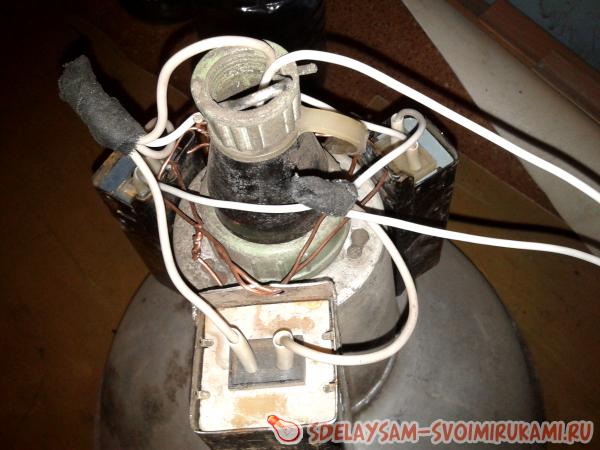

One wire from the 220 socket connects to one end of the chokes, and the other wire from the 220 socket goes straight to the lamp. The wire from the output of the chokes goes to the second contact of the lamp. The option of mounting chokes on the luminaire body can be seen in the photographs.

It also shows how the wires are connected. It is very important to ensure that the contacts on the choke terminals are well connected, otherwise they will spark and heat. In the photo you can see how such a choke works and starts the DRL 250 lamp.
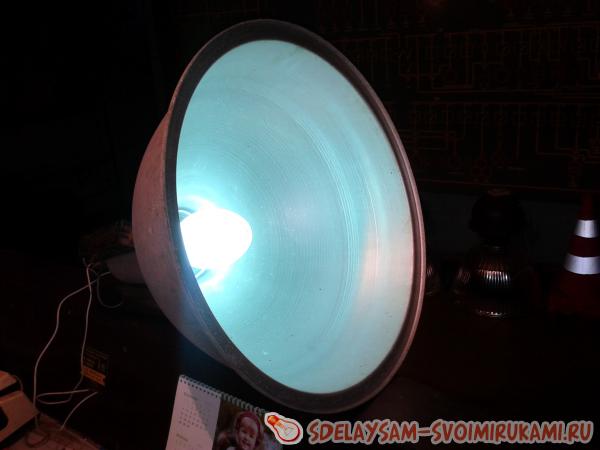
This design has been made and tested with good results. In addition to mounting chokes on lamps, you can make a separate box in which they will be located, and lead the wires from it to the lamp. This assembly option will be much cheaper than buying a special choke. I would like to remind you that according to the rules for installing DRL lamps, they must be at a height of at least three meters. Since it is believed that they emit a lot of ultraviolet radiation, which is undesirable for human skin.
That's all. Try it and you will succeed.


